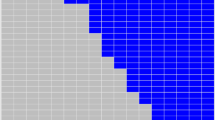Abstract
The financial problems of colleges under 1,000 in enrollment cannot be blamed entirely on a set of minimum, or “fixed,” costs that colleges of any size must bear. Enrollment fluctuations and lower tuitions also contribute to financial difficulties. In the past, colleges have used growth not so much to capitalize on economies of scale as to provide evidence of success to their constituents. As a result, the ranks of small colleges remain populated with those institutions experiencing financial difficulty, while more successful institutions have attained a larger size. However, in an era of limited growth potential, small colleges must not look to growth as a symbol of success. Success will be better equated with the continuation of quality academic programs in a closely knit community.
Similar content being viewed by others
References
Astin, A. W., and Lee, C. B. T.The invisible colleges. New York: McGraw-Hill, 1972.
Baldridge, J. V., and Tierney, M. L.New approaches to management. San Francisco: Jossey-Bass, 1979.
Dickmeyer, N.Comparative financial statistics for community and junior colleges, 1978–1979. Washington, D.C.: National Association of College and University Business Officers, 1980.
Dickmeyer, N., and Hughes, K. S.Comparative financial statistics for community and junior colleges, 1977–1978. Washington, D.C.: National Association of College and University Business Officers, 1979.
Carnegie Commission on Higher Education.New students and new places. New York: McGraw-Hill, 1971.
Corrallo, S.An Analysis of Instructional Expenditures for Institutions of Higher Education in the Northeast United States. Doctoral Dissertation. State University of New York at Buffalo, 1970.
Jenny, H. Institutional financial assessment: methodology and meaning.Research in Higher Education 1979,10(1), 59–70.
Jordan, T. E. An exploration of the relationship among size, cost and selected educational opportunities in certain Texas public junior colleges. Doctoral dissertation, University of Houston, 1965.
Kershaw, J. A.The very small college. New York: The Ford Foundation, 1976.
McLaughlin, G. W., Montgomery, J. R., Smith, A. W., Mahan, B. T. and Broomall, L. W. Size and efficiency.Research in Higher Education 1980,12(1), 53–66.
Marks, J. L. Forces shaping the humanities in public two-year colleges. Doctoral dissertation. University of Arizona, 1980.
Mayhew, L. B.Survival in the eighties. San Francisco: Jossey-Bass, 1980.
Author information
Authors and Affiliations
Rights and permissions
About this article
Cite this article
Dickmeyer, N. Small independent colleges and economies of scale. Res High Educ 17, 51–67 (1982). https://doi.org/10.1007/BF00973663
Received:
Issue Date:
DOI: https://doi.org/10.1007/BF00973663




